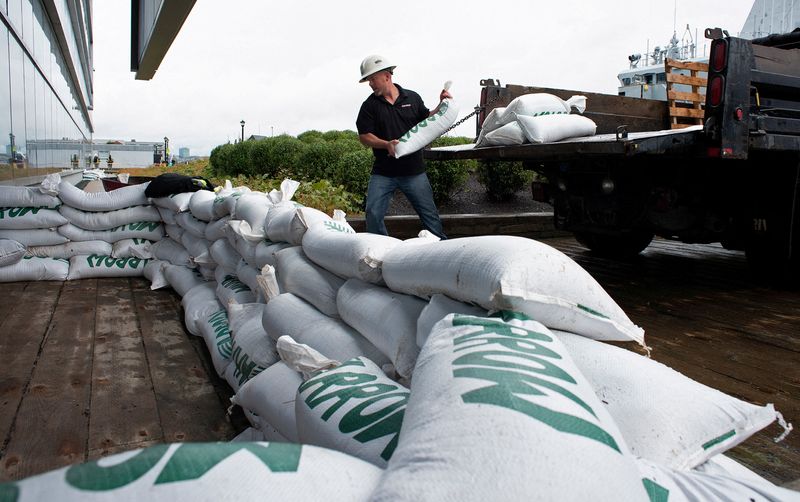Storm Fiona hammers east Canada coast, knocks out power to many By Reuters

© Reuters. FILE PHOTO: Francis Bruhm, Project Manager for general contractor G&R Kelly, places sandbags around the doors of the Nova Scotia Power building before the arrival of Hurricane Fiona in Halifax, Nova Scotia, Canada September 23, 2022. REUTERS/Ingrid Bulme
By Eric Martyn and John Morris
HALIFAX, Nova Scotia (Reuters) -Powerful storm Fiona slammed into eastern Canada on Saturday with hurricane-force winds, blowing over trees and powerlines and leaving hundreds of thousands of homes and businesses without electricity.
The U.S. National Hurricane Center said the center of the storm, now called Post-Tropical Cyclone Fiona, was now in the Gulf of St. Lawrence after racing through Nova Scotia. Reports of downed trees and power lines were widespread in Nova Scotia and Prince Edward Island.
Fiona, which nearly a week ago devastated parts of the Caribbean, made landfall between Canso and Guysborough, Nova Scotia, where the Canadian Hurricane Centre said it recorded what could have been the storm with the lowest barometric pressure to hit land in the country’s history.
Some 79% of customers, or 414,000, were without power in Nova Scotia, and 95%, or 82,000, had lost power on Prince Edward Island, utility companies said. The region was also seeing spotty mobile phone service. Police across the region reported multiple road closures.
The storm weakened somewhat as it travelled north. As of 8 a.m. (1200 GMT), it was over the Gulf of St. Lawrence about 200 miles (340 km) northeast of Halifax, carrying maximum winds of 85 miles per hour (140 kph) and barrelling north at around 23 mph (37 kph), the NHC said.
Experts predicted high winds, storm surges and heavy rainfall from Fiona. The storm was forecast to gradually weaken but was expected to maintain hurricane-force winds until Saturday afternoon, the NHC said.
Formerly designated a hurricane, Fiona battered Caribbean islands earlier in the week, killing at least eight people and knocking out power for virtually all of Puerto Rico’s 3.3 million people during a sweltering heat wave. Nearly a million people remained without power five days later.
Canadian Prime Minister Justin Trudeau delayed Saturday’s departure for Japan, where he was to attend the funeral of former Prime Minister Shinzo Abe, to receive briefings and support the government’s emergency response, Press Secretary Cecely Roy said on Twitter (NYSE:).
A hurricane warning was in effect for much of central Nova Scotia and Prince Edward Island, home to more than 150,000 people, and parts of Newfoundland, the Miami-based NHC said.
Canadian authorities sent emergency alerts in Nova Scotia and Prince Edward Island, warning of severe flooding along shorelines and extremely dangerous waves. People in coastal areas were advised to evacuate.
“We’ve had a few before, but they say this is going to be the biggest of them all,” said Chris MacPhee, 53, of Sydney, Nova Scotia, who stocked up on groceries, batteries and candles. He said he was feeling “a little nervous, I guess.”
The storm could prove to be more ferocious than the benchmarks of Hurricane Juan in 2003 and Hurricane Dorian in 2019, Canadian Hurricane Centre meteorologist Bob Robichaud told a briefing on Friday.
The country’s two largest carriers, Air Canada and WestJet Airlines, suspended regional service starting Friday evening.
(Reporting Eric Martyn in Halifax and John Morris in Stephenville; Additional reporting by Ivelisse Rivera in San Juan, Puerto Rico and Juby Babu in Bengaluru, Ismail Shakil and Steve Scherer in OttawaWriting by Steve Scherer, Daniel Trotta Editing by Gerry Doyle, Jane Merriman and Frances Kerry)
For all the latest Business News Click Here
For the latest news and updates, follow us on Google News.
